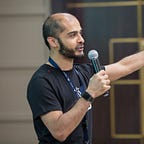Consciously Engineering Breakthroughs
Face the truth, unlock your potential…
Breakthroughs in thinking (and outcomes). Everyone seems to want them.
Scaling new heights.
Expanding one’s horizons.
Realizing true potential.
How can one consciously engineer these breakthroughs then?
With all outcomes (breakthrough or otherwise) a result of actions and behaviors driven by our implicit and/or explicit thinking and accompanying beliefs, logic would have our unpacking these originating thoughts. And one could argue this is where the breakthrough journey starts (or doesn’t)…
Dan Sullivan from Strategic Coach says that all progress starts by telling the truth. If we are unable to decipher (and embrace) the truth, we’ll stay locked in the certainty of our past successes and results (and assumptions). If our entire calculus is based on the same inputs (viz assumptions), then how real is the expectation of a different result, especially a breakthrough one? With these assumptions appearing as self-evident truths, they escape the questioning and challenge, that could open the door to breakthrough thinking. We stay stuck in the evergreen comfort zones of the past and simply refurbish the old for a new, a masked (and often uninspiring) version of the heydays of yesteryears.
Beyond the required internal mindset shift, breakthrough thinking is also often accelerated by exponential technologies since they have an unemotional attachment to what was. They are a force multiplier that moves through the 6 Ds as conceptualized by my mentor Peter Diamandis, going through a cycle of digitization, deception, disruption, demonetization, dematerialization, and democratization — a “chain reaction of technological progression, a road map of rapid development that always leads to enormous upheaval and opportunity”.
There would be no search engines like Google if yellow pages didn’t seem to be good enough.
There would be no mobile phones like iPhone or OnePlus if the red phone boxes or fixed telephone handsets weren’t seen to be too unwieldy to move around.
There would be no e-commerce sites like Amazon if all our shopping needs were adequately met by existing retail structures.
In 2003 science fiction author William Gibson quipped:
“The future is already here — it is just not evenly distributed.”
A quote, as Pascal Finette reminded us, has been repeated many, many times to emphasize the idea that, to see the future, we don’t need all that much genius and foresight, but rather access (and sometimes money).
So if breakthrough thinking is about uncovering a future that’s already playing out somewhere (maybe even in a different domain), which of our (previously) hard-learned perspectives and insights are we willing to let go, so that we are able to elevate our sense of presence & curiosity for accessing these new streams of thinking?
How easy would it be for the leadership teams of market-leading organizations to press a temporary ‘pause’ and list out all the current assumptions they’re operating from, and start reinventing their listening and thinking for those assumptions that don’t serve them?
How comfortable would it be for sectoral leaders in domains such as education & climate that are bogged by super wicked problems to unpack what they consider to be self-evident truths (and seemingly essential for their survival and success), so as to open their minds to insights from sources and stakeholders they never considered previously inviting to the strategic high table?
Breakthrough thinking starts with facing the truth and that requires courage, patience, and wisdom.
And that’s a breakthrough in itself.
